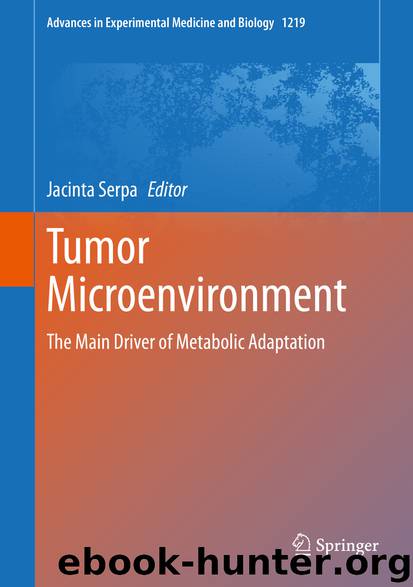Tumor Microenvironment by Jacinta Serpa

Author:Jacinta Serpa
Language: eng
Format: epub
ISBN: 9783030340254
Publisher: Springer International Publishing
One certainty regarding melanoma is that the metabolic reprogramming that occurs in tumour cells has an accentuated impact in the immune system and, consequently, in immunotherapy. Since melanoma is particularly resistant to the traditional radio and chemotherapies, the use of kinase inhibitors and immunocheckpoint therapies (target therapies) has been rising in recent years to treat metastatic melanoma (Kalal et al. 2017). As previously explained, the inhibition of BRAFV600E derived from the administration of vemurafenib, dabrafenib, trametinib and cobimetinib can suppress the expression of glycolytic enzymes and regulators such as HIF1α and MYC, inducing a reduction in glucose consumption (Parmenter et al. 2014). Interestingly, the resistance to BRAF inhibitors is mediated by the oxidative metabolism, since the treatment with vemurafenib enhances the mitochondrial respiration rate and ROS production (reviewed in Corazao-Rozas et al. 2013). In these conditions, the overexpression of PGC1α, the key cofactor in mitochondrial genesis, is enough to restore mitochondrial activity (Vazquez et al. 2013). Furthermore, in vitro studies combining vemurafenib and an inhibitor of mitochondrial respiration increased the BRAF inhibitor related cell death, confirming that mitochondrial activity is used by melanoma cells as a mechanism against drugs (Zaal and Berkers 2018). It was also suggested that this increase in oxidative metabolism is correlated with a metabolic switch that makes cells more dependent on glutamine rather than glucose (Dhomen et al. 2015). Moreover, studies using melanoma cell lines revealed evidence that MAPK inhibitors combined with a glutaminase inhibitor could be a viable therapeutic approach for melanoma, which demonstrate resistance developed via reactivation of oxidative metabolism (Dhomen et al. 2015). In addition, there are several compensatory mechanisms that could occur in MAPK signalling pathway and even in the PI3K/AKT pathway that can potentiate BRAF inhibitors resistance (McCubrey et al. 2015), such as the overactivation of downstream kinases by oncogenic mutations in RAS or MEK (reviewed in Griffin et al. 2017).
Even though combined BRAF and MEK inhibitor therapies lead to a better clinical response, the adverse effects resulting from this treatment are a major concern. Moreover, resistance to these therapies remains an obstacle (Wang et al. 2018), as the most common form of resistance results from the reactivation of the signalling pathway which is the target of the therapy (Van Allen et al. 2014). Considering all the currently available information, the combination between target therapies and metabolic inhibitors could be a viable therapeutic opportunity. Nevertheless, alternative therapies to answer the challenges presented by melanoma have been developed in the form of immunotherapies. For instance, ipilimumab is an antibody that targets the cytotoxic T-lymphocyte-associated protein 4 (CTLA-4), inhibiting its signalling on T cells (Wolchok et al. 2010). It has been shown that CTLA-4 expression increases significantly after CD4+ and CD8+ T cell activation (Alegre et al. 2000). It competes with CD28 to bind with CD80 and CD86, which are present on the surface of macrophages and other antigen presenting cells (Walunas et al. 1996). Due to the fact that CTLA-4 has a higher affinity for CD80 and CD86 than CD28, it will result in a more favourable binding of these molecules when compared with the later (Walunas et al.
Download
This site does not store any files on its server. We only index and link to content provided by other sites. Please contact the content providers to delete copyright contents if any and email us, we'll remove relevant links or contents immediately.
| Administration & Medicine Economics | Allied Health Professions |
| Basic Sciences | Dentistry |
| History | Medical Informatics |
| Medicine | Nursing |
| Pharmacology | Psychology |
| Research | Veterinary Medicine |
Tuesdays with Morrie by Mitch Albom(4692)
Yoga Anatomy by Kaminoff Leslie(4306)
Science and Development of Muscle Hypertrophy by Brad Schoenfeld(4089)
Bodyweight Strength Training: 12 Weeks to Build Muscle and Burn Fat by Jay Cardiello(3915)
Introduction to Kinesiology by Shirl J. Hoffman(3725)
How Music Works by David Byrne(3187)
Sapiens and Homo Deus by Yuval Noah Harari(2987)
The Plant Paradox by Dr. Steven R. Gundry M.D(2547)
Churchill by Paul Johnson(2506)
Insomniac City by Bill Hayes(2498)
Coroner's Journal by Louis Cataldie(2432)
Hashimoto's Protocol by Izabella Wentz PharmD(2331)
The Chimp Paradox by Peters Dr Steve(2297)
The Universe Inside You by Brian Clegg(2097)
Don't Look Behind You by Lois Duncan(2080)
The Immune System Recovery Plan by Susan Blum(2029)
The Hot Zone by Richard Preston(1983)
Endure by Alex Hutchinson(1964)
Woman: An Intimate Geography by Natalie Angier(1882)
